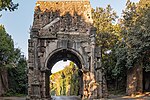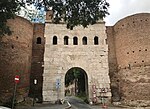Santa Maria in Palmis
1637 establishments in Italy17th-century Roman Catholic church buildings in ItalyRelics associated with JesusRoman Catholic churches completed in 1637Roman Catholic churches in Rome ... and 1 more
Rome Q. IX Appio-Latino

Santa Maria in Palmis (Italian: Chiesa di Santa Maria delle Piante; Latin: Sanctae Mariae in Palmis), also known as Chiesa del Domine Quo Vadis, is a small church southeast of Rome. It is located about some 800 m from Porta San Sebastiano, where the Via Ardeatina branches off the Appian Way, on the site where, according to the apocryphal Acts of Peter, Saint Peter met the risen Christ while Petrus was fleeing persecution in Rome. According to the tradition, Peter asked him, "Lord, where are you going?" (Latin: Domine, quo vadis?). Christ answered, "I am going to Rome to be crucified again" (Latin: Eo Romam iterum crucifigi).
Excerpt from the Wikipedia article Santa Maria in Palmis (License: CC BY-SA 3.0, Authors, Images).Santa Maria in Palmis
Via Appia Antica, Rome Municipio Roma VIII
Geographical coordinates (GPS) Address Phone number Website External links Nearby Places Show on map
Geographical coordinates (GPS)
| Latitude | Longitude |
|---|---|
| N 41.8665 ° | E 12.503722222222 ° |
Address
Chiesa del Domine Quo Vadis (Santa Maria delle Piante)
Via Appia Antica 51
00014 Rome, Municipio Roma VIII
Lazio, Italy
Open on Google Maps







